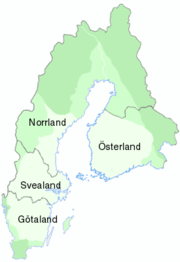Lands of Sweden

The lands of Sweden (Swedish: Sveriges landsdelar) are three traditional parts, essentially three collectives of provinces, in Sweden. These "lands" have no administrative function, and there is no official designation for this subdivision level. Most commonly they are called "landsdelar", which simply translates to "parts of the country".
Subdivision
- Götaland (Gothenland or Gothia, "Land of the Götar" or "Land of the Geats") is the southern, most densely populated part, consisting of ten provinces.
- Svealand (Swealand, "Land of the Swedes") is the central part, named after the historic Sweden proper, which is the smallest of the three parts with six provinces; the capital and administrative centre of Sweden has been situated here at least since the late Middle Ages.
- Norrland (literally "Northlands") is the northern part, which is the largest of the three parts, covering 60 percent of the total Swedish territory with nine provinces. The three northernmost provinces are sometimes called Övre (Upper) Norrland while the rest of the provinces are then called Nedre (Lower) Norrland.
Although they have no administrative functions and no coats of arms these three subdivisions are used in weather reports. Their boundaries can therefore be seen on weather maps on television and in the press.
Areas and populations of the lands:
| Land | Population (2005) |
Area (km²) |
Number of provinces | Provinces |
|---|---|---|---|---|
| Götaland | 4,351,658 | 97,841 | 10 | Scania, Blekinge, Halland, Småland, Öland, Gotland, Östergötland, Västergötland, Dalsland and Bohuslän |
| Svealand | 3,539,944 | 91,098 | 6 | Södermanland, Uppland, Västmanland, Närke, Värmland and Dalarna |
| Norrland | 1,156,150 | 261,292 | 9 | Gästrikland, Hälsingland, Härjedalen, Jämtland, Medelpad, Ångermanland, Västerbotten, Norrbotten and Lappland |
Historical lands

Sweden was historically divided into the four lands: Götaland, Svealand, Norrland and Österland.
- Österland (literally Eastlands) is an old name for southern Finland. The term has been obsolete since the 15th century and is virtually unknown in Sweden today. In most dictionaries "österlandet" simply means the orient.
- Norrland was the name for the annexed lands to the north on both sides of the Gulf of Bothnia.
- In Sweden's prehistoric times Sweden was largely restricted to Svealand and southern Norrland, while Götaland is mentioned in legends as a rival kingdom, and traditions of Swedish-Geatish wars survive in the Anglo-Saxon epic Beowulf. Eventually the two countries were united under one crown by the Swedish kings at some time between 550–1200 (the date is the matter of debate).
In the Second Treaty of Brömsebro (1645) Denmark-Norway ceded the Norwegian provinces of Jämtland and Härjedalen to Sweden. These provinces are counted as part of Norrland. In the Treaty of Roskilde (1658), Denmark-Norway ceded Scania, Blekinge and Halland (Skåneland) and Bohuslän to Sweden. These provinces are since then counted as parts of Götaland.
After the Finnish War (1808–1809) the eastern part of Sweden was ceded to Russia, thus becoming the Imperial Russian Grand Duchy of Finland, with Norrland divided between these two states. The Swedish portion of Norrland still represents more than half of Sweden's territory; it remains, however, sparsely populated compared to the south and middle. The town of Stockholm, which earlier had been at the centre of the medieval provinces of Sweden (i.e. the brightest area on the map), now was situated on the eastern edge of the realm.
See also
- Subdivisions of the Nordic countries
- Old Finland
- Lands of Denmark
- Dominions of Sweden
- Provinces of Sweden
- Historical provinces of Finland
External links
![]() Media related to Category:Lands of Sweden at Wikimedia Commons
Media related to Category:Lands of Sweden at Wikimedia Commons
- Courts of Appeal: The Court Districts of Sweden - Official site of The National Courts Administration

